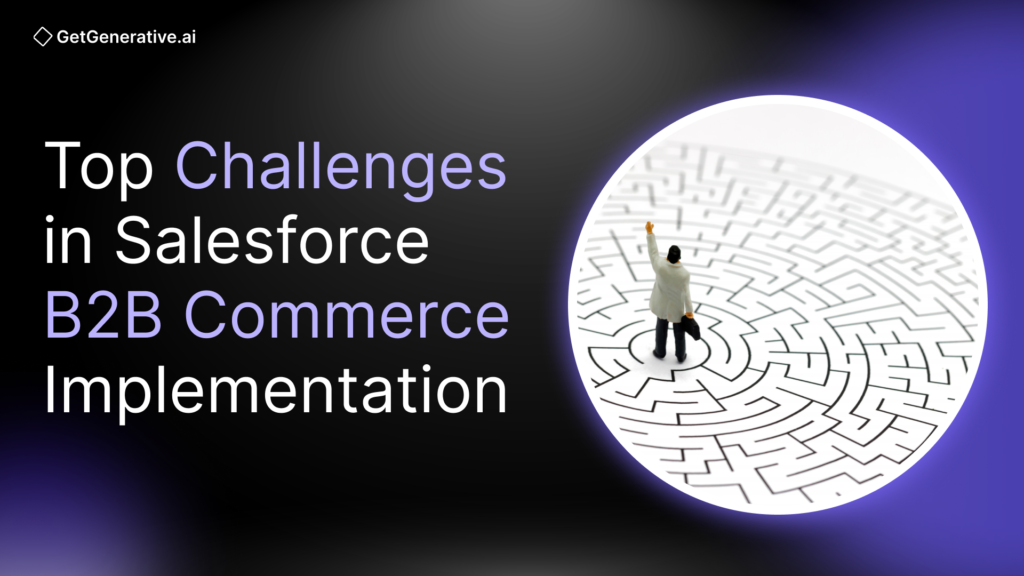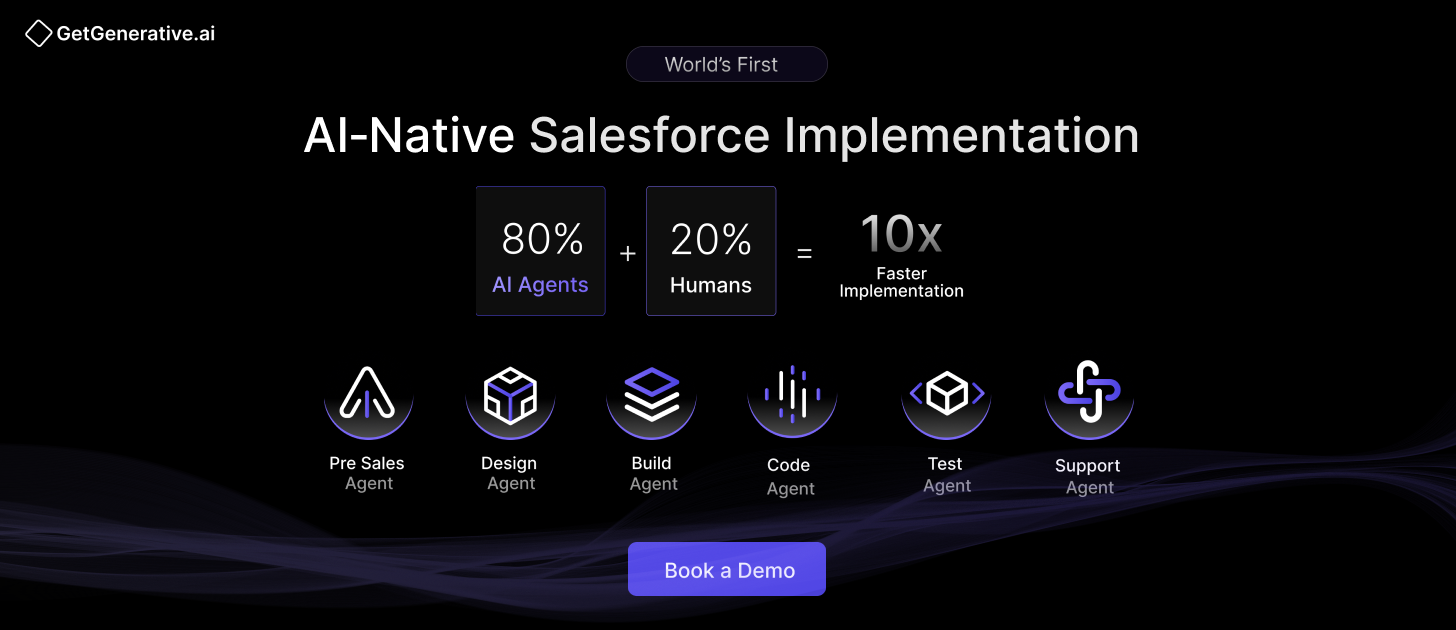Top Challenges in Salesforce B2B Commerce Implementation
Implementing Salesforce for B2B commerce has become a cornerstone for businesses looking to streamline operations and boost customer engagement. However, like any transformative process, it comes with challenges.
Let’s break down the top implementation challenges and how to mitigate them.
Challenge 1: Data Migration and Integration
1.1 Migrating Fragmented Legacy Data
Large B2B companies often operate with decades-old systems storing inconsistent, duplicate, or outdated customer and product data. A failed data migration can compromise customer experiences and pricing accuracy.
What’s at stake:
Poor data quality leads to errors in order history, incorrect pricing, or broken entitlements.
Best practices:
Conduct a data audit to classify essential vs. redundant records.
Clean, normalize, and deduplicate customer, product, and pricing data before import.
Utilize Salesforce tools such as the Data Import Wizard, Data Loader, or ETL platforms (e.g., Informatica, Talend).
Perform phased migrations to avoid downtime—start with sandbox environments and cutover in stages.
1.2 Integrating ERP, CRM, and OMS
Salesforce B2B Commerce must integrate seamlessly with core systems, such as SAP, Oracle, NetSuite, or AS/400, to handle pricing, fulfillment, and credit approvals. But data models often don’t align—legacy ERP might use composite keys while Salesforce uses UUIDs.
Integration challenges include:
Mismatched schemas (e.g., units of measure, product hierarchies)
API limits and throttling issues
Ensuring real-time updates for stock and order statuses
Recommended tools:
MuleSoft (Salesforce’s native middleware)
Boomi, Jitterbit, or SAP CPI for hybrid architectures
Use external IDs, bi-directional sync, and middleware transformations
1.3 Navigating Platform Data Limits
Salesforce B2B Commerce has defined thresholds:
| Limit Type | Standard Limit |
| Products per store | 4 million |
| Variants | 300 million |
| Buyer entitlements per product | 2,000 |
| Product images | 9 per product |
If your enterprise exceeds these (e.g., 5M SKUs), you’ll need workarounds such as external search engines (Algolia, Coveo) or limit increase requests.
Design tips:
Flatten product hierarchies.
Archive obsolete SKUs.
Pre-plan entitlements and attribute counts.
Also Read – Key Features of Salesforce B2B Commerce Cloud
Challenge 2: Customization vs. Maintainability
2.1 Excessive Customization
Custom logic in checkout, pricing, or storefront UI may improve UX—but often breaks upgrades. Since Salesforce releases updates 3x a year, heavy customizations can cause regressions.
How to balance customization:
Use Commerce App Templates and standard widgets first.
Only extend using Lightning Web Components (LWC) or modular Apex where needed.
Stick to Salesforce SDKs and APIs rather than modifying the DOM or core layouts.
2.2 Performance and Scalability
Slow-loading catalogs, inefficient filters, or complex queries degrade user experience—especially at scale.
Recommendations:
Use CDNs for static assets (e.g., Akamai, Cloudflare).
Limit search result sets and use faceted filtering.
Load-test your commerce flows—particularly large product searches or quote calculations.
Search Optimization Tips:
Limit searchable attributes.
Boost relevant keywords.
Offload large queries to external search providers like Coveo or ElasticSearch when Einstein Search doesn’t scale.
Challenge 3: Omnichannel Experience
3.1 Delivering a Consumer-Grade Buying Journey
Only 40% of B2B companies meet buyer expectations for omnichannel, despite 60% saying it’s a strategic priority. This gap widens if pricing, support, and product info are inconsistent across channels.
To resolve this:
Integrate Sales Cloud, Service Cloud, and Experience Cloud.
Sync CRM account hierarchies with commerce entitlements.
Display contract-based pricing, customer-specific catalogs, and real-time order history on the storefront.
3.2 Supporting Mobile and Multi-Site Experiences
A growing share of B2B users browse and buy via smartphones. Salesforce offers mobile-optimized templates and Progressive Web App (PWA) features—but companies must implement them thoughtfully.
Recommendations:
Optimize all flows (reorders, quotes, cart) for mobile.
Use multi-currency and multi-language features for global operations.
Ensure local tax rules, payments, and shipping APIs are region-ready.
Challenge 4: User Adoption and Change Management
4.1 Driving Internal Adoption
Even the most advanced B2B commerce platform fails without user buy-in. Sales reps, service agents, and operations staff may resist switching from legacy tools or offline workflows.
Common adoption barriers:
Lack of training
Misaligned workflows
Unclear value proposition to users
Best practices:
Start early: Include stakeholders from Sales, Support, and Ops in the implementation phase.
Provide role-specific training (e.g., sales reps learning quote approvals, service agents checking order statuses).
Set up sandbox environments for hands-on practice.
Identify and empower “champions” who advocate for the platform in each department.
Track user engagement metrics like login frequency, data completeness, and feature usage.
4.2 Aligning Stakeholders
Cross-functional misalignment is one of the top reasons B2B commerce projects stall. While Marketing may push for UI features, Finance focuses on ERP sync, and Sales want quoting tools—without alignment, scope creep and delays are inevitable.
Recommendation:
Form a steering committee with decision-makers from IT, Sales, Marketing, Finance, and Customer Support.
Define clear success KPIs such as:
“Reduce manual order errors by 40%”
“Increase self-service transactions by 30%”
Use agile sprints and demos to maintain transparency and build consensus across teams.
Challenge 5: Cost Management and ROI
5.1 Budgeting and Controlling Scope Creep
Implementing Salesforce B2B Commerce isn’t cheap. Between licensing, integration, custom development, and change management, costs can spiral quickly.
Cost drivers:
Unforeseen complexity in legacy data
Custom integration work
Third-party add-ons and apps
Prolonged user testing or change management
Solutions:
Build a detailed discovery and scoping phase with stakeholder input.
Estimate each technical workstream and add 20–30% contingency.
Track spending across categories—licensing, services, integrations, and ongoing enhancements.
Choose AppExchange vendors carefully—some payment gateways, tax calculators, or product configurators charge hefty fees.
5.2 Proving ROI and Time-to-Value
Stakeholders will ask: How soon does this investment pay off?
B2B Commerce implementations can take 6–9 months to go live. Accelerating ROI means showing measurable wins early.
Suggestions:
Launch a pilot store for one region, product line, or customer segment.
Use Salesforce reports to monitor:
Online order volume
Conversion rates
Quote-to-order time
Highlight manual process elimination: e.g., if order entry automation saves 10 minutes per transaction, calculate productivity gains.
Measure support call reduction via customer self-service adoption.
Challenge 6: Security, Compliance, and Governance
6.1 Data Security and Access Management
B2B commerce involves sensitive data—corporate pricing, negotiated contracts, and credit terms. Misconfiguring roles can create risks.
Mitigation strategies:
Use role-based access control (RBAC)
Restrict API keys and admin permissions
Enable multi-factor authentication (MFA)
Leverage Salesforce Shield for data encryption, field audit trails, and event monitoring
6.2 Regulatory Compliance (GDPR, HIPAA, etc.)
If your customers include EU entities or healthcare/finance organizations, compliance is non-negotiable.
Ensure compliance by:
Implementing consent tracking for customer records
Storing data in region-compliant environments
Setting up audit logs and retention policies
Vetting third-party ISVs (e.g., payment, analytics) for regulatory adherence
Also Read – Salesforce B2B Commerce Implementation Guide 2025
Strategic Recommendations for Implementation Success
Based on the challenges above, here are the most critical success strategies:
✅ Rigorous Planning & Scoping
Document workflows, integrations, data schemas
Use agile phases: MVP, then progressive enhancement
Prioritize features by business impact
✅ Cross-Functional Alignment
Establish governance early
Set measurable KPIs for sales, marketing, IT
Host regular demos to maintain momentum
✅ Salesforce & Partner Ecosystem Leverage
Use Trailhead, Salesforce Architect guides
Choose certified implementation partners
Use MuleSoft or Boomi for ERP syncs
✅ Data Quality and Stewardship
Clean data before import
Assign data owners for objects (Products, Accounts)
Schedule periodic data audits
✅ Continuous Training & Feedback Loops
Use in-role training + real scenarios
Enable feedback through UAT and help desk
Track training effectiveness via adoption metrics
✅ Performance and Monitoring Discipline
Use Salesforce Performance Assistant
Monitor API limits, page load times, error logs
Load-test for traffic spikes
✅ Mobile and Global Readiness
Test every workflow on mobile
Use PWA and responsive design
Set up localized tax, payment, and language configs from the start
Conclusion
While implementing Salesforce B2B commerce comes with challenges, the benefits far outweigh the obstacles. By addressing data migration, user adoption, integration, and scalability issues proactively, businesses can unlock Salesforce’s full potential. A strategic approach and expert guidance will ensure your Salesforce implementation becomes a stepping stone to success.
At GetGenerative.ai, we’ve reimagined Salesforce implementation—built from the ground up with AI at the core. This isn’t legacy delivery with AI added on. It’s a faster, smarter, AI-native approach powered by our proprietary platform.
👉 Explore our Salesforce AI consulting services
FAQs
1. What are the key steps to ensure successful data migration?
Conduct a thorough data assessment, clean and validate data, and use automation tools like ETL for accurate migration.
2. How can I improve user adoption for Salesforce?
Offer personalized training, showcase Salesforce’s user-friendly features, and highlight its impact on daily operations.
3. How do I secure sensitive data during Salesforce implementation?
Use role-based access controls, data encryption, and regular security audits to protect data.
4. Why is scalability important in Salesforce implementation?
Scalability ensures your system can handle future growth without disruptions, saving time and costs on upgrades.
5. When should I hire a Salesforce consultant?
Engage a Salesforce consultant early in the planning phase to identify challenges, refine goals, and ensure smooth implementation.




